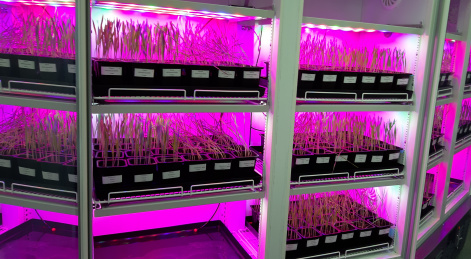Herbicides loaded into a polymer matrix will ensure plant health
28 August 2020 г.

An environmentally friendly way of delivering fertilizers is needed to protect crops. For example, biopolymers as carriers for pesticides could be such an option. They have an important advantage, such as the ability to decompose in soils into components which are safe for nature. However, the most important disadvantage of biopolymers and their products is their high cost.
Siberian scientists created an inexpensive composite material based on biopolymers. Using bacteria, the researchers synthesized a biopolymer in a medium with vegetable oils. By mixing it with natural fillers, they were able to propose an alternative option for delivering herbicides in the form of microparticles, tablets, and granules. The main task was not to harm agroecosystems, remove weeds and maintain soil fertility.
The main material of the developed forms is biopolymer. Experts conducted a study on the growth of the Cupriavidus necator B-10646 strain on various oils in order to reduce the cost of the biopolymer. For the synthesis of this polymer, scientists used palm oil, camelina oil and two types of sunflower seed oil (refined and unrefined).
“Vegetable oils are currently being considered as a potential carbon substrate for the synthesis of polyhydroxyalkanoates. In addition to the low cost of lipid substrates, the economic coefficient for the polymer obtained from vegetable oils is higher than for sugars, that is, to obtain 1 g of polymer, 1.3-1.5 g of oil are needed, while sugars (glucose, fructose) will require 3- 3.3 g. As a result, all this leads to a decrease in the cost price of the finished polymer, "says Natalya Zhila, candidate of Biological Sciences, senior researcher of the Chemoautotrophic Biosynthesis Laboratory at the Institute of Biophysics KSC SB RAS, associate professor of the Basic Department of Biotechnology at the Siberian Federal University.
According to the biologist, among the oils studied, “palm oil was the best substrate for bacterial growth and polymer synthesis. The biomass concentration and polymer content were comparable to those obtained with sugars.
“In all the studied vegetable oils, the bacteria synthesized a three-component polymer consisting of monomers of 3-hydroxybutyrate, 3-hydroxyvalerate and 3-hydroxyhexanoate. Compared with the homopolymer P (3GB), the polyhydroxyalkanoates obtained using oils were characterized by a lower molecular weight and lower melting points and thermal degradation. We used vegetable oils differing significantly in their fatty acid composition. The intake of fatty acids by bacteria depended on the oil used. So, when growing on palm oil, bacteria evenly consumed all the fatty acids which make up the oil, while when we cultivated bacteria on camelina and sunflower oils, the bacteria first of all utilized polyenoic acids, that is, acids containing 2 and 3 double bonds, ” explains Natalya Zhila.
One of the most promising applications of such a polymer is as an environmentally friendly means of delivering herbicides for biotechnology. Since the material is synthesized by microorganisms, it can also be decomposed by them without harming the environment. The experts studied how natural materials and the polymer interact, and based on the information obtained, they created powder composites to deliver pesticides and fertilizers to plants through the soil.
“Such materials have a prolonged effect. They are introduced into the soil during sowing together with seeds and act throughout the growing season, which is now being tested in field experiments. This approach will be more economical and will make it safer to work with herbicides, since a toxic pesticide is contained in the polymer matrix,” says Evgeny Kiselev, Candidate of Technical Sciences, researcher at the Laboratory of Chemoautotrophic Biosynthesis, Institute of Biophysics KSC SB RAS and Laboratory of Biotechnology of New Biomaterials, Siberian Federal University.
Noting the advantages of the proposed method, the scientist explains: “We are trying to present an alternative way of using agricultural chemistry. In the conventional method of introducing herbicides (spraying), they are applied to the surface of plants and soil, and they can easily be washed off. And in rainy weather, this treatment must be repeated. In our case, systemic pesticides are used, which can be absorbed by the root system and move along the plant capillaries. The drug is introduced into the soil in the form of hard granules, which ensures its preservation. The polymer matrix is hydrophobic, that is, it is insoluble in water, and the drug, being in such an envelope, is gradually released."
Source: Scientific Russia.
Share:
